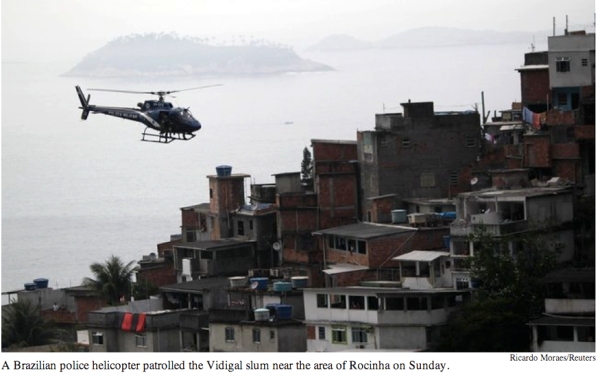RIO DE JANEIRO — Three thousand troops backed by helicopters and armored cars occupied Rio de Janeiro’s largest slum on Sunday, another step in the city’s bid to improve security and reign in drug gangs.
The occupation of the area called Rocinha, a notorious hillside neighborhood that overlooks some of Rio’s swankiest areas, is a crucial part of the city’s preparations to host soccer’s World Cup in 2014 and the Olympics two years later.
Security forces have occupied nearly 20 slums in the last three years but none as symbolically or strategically important as Rocinha, a sprawl of shacks, stores and evangelical churches at a traffic choke point between the main city and western areas where most Olympic events will be held.
With army helicopters overhead, troops began climbing the slum’s winding roads just after 4 a.m. and declared the operation a success within two hours after encountering no resistance.
The takeover of Rocinha and the nearby Vidigal slum was as much a media event as a military operation. Hundreds of reporters followed soldiers and police through deserted, garbage-strewn streets. The authorities had announced their plans days in advance, giving gang members plenty of notice to flee.
According to TV news channel GloboNews, only one person was detained during the operation.
After years of living in fear of both gang members and the often-violent tactics of police, residents were wary of embracing the new reality.
“Let’s hope for the best, but there’s a lot more that needs to be done,” said Sergio Pimentel, a funeral director sitting outside his business watching the operation unfold.
He pointed to an alley that he said poured raw sewage on to the street whenever it rained.
“We need basic sanitation, health, education,” Mr. Pimentel said. “They have to come in with everything, not just the police.”
The sprawling hillside community, home to about 100,000 people, has one of Brazil’s worst rates of tuberculosis, officials say. It is often described as the largest slum in Latin America and is believed to be the main drug distribution point in Brazil’s second-largest city.
Under a so-called “pacification” program, Rio authorities are following up invasions by handing slums over to specially trained community police and providing services like health centers and formal electricity and TV supply. The aim is to foster social inclusion and give the city’s one million or more slum residents a bigger stake in Brazil’s economy.
Progress has sometimes been slow, however. A year after a similar operation to occupy a large slum called Alemao, the favela has yet to receive a community police force as the security forces struggle to train enough officers.
Most of the occupations have taken place in slums close to Rio’s wealthier areas, leading to criticism that the program is aimed mostly at supporting the city’s real-estate boom and preparing for the sports events.



10 Comments
Jump to comment form | comment rss [?] | trackback uri [?]